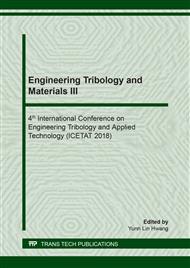[1]
M. Nishira, M. Sugimoto, O. Takano: Properties of Electroless Ni-P-SiC Composite Coatings, Journal of the Surface Finishing Society of Japan, Vol. 41 (1990), p.407.
DOI: 10.4139/sfj.41.407
Google Scholar
[2]
O. Takano, M. Nishira, M. Sugimoto: Factors Affecting the Formation of Electroless Ni-P-SiC Composite Coatings, Journal of the Metal Finishing Society of Japan, Vol. 39 (1988), p.705.
DOI: 10.4139/sfj1950.39.705
Google Scholar
[3]
N. Takeuchi, T. Nagai, T. Miura: The Adhesive Wear Resistance of Ni-SiC Electrodeposited Composite Coatings, Journal of the Metal Finishing Society of Japan, Vol. 37 (1986), p.73.
DOI: 10.4139/sfj1950.37.73
Google Scholar
[4]
M. Hino, M. Hiramatsu, M. Tsujikawa, M. Kawamoto, K. Demizu: Friction and Wear Properties of Electroless Ni-P-SiC/PTFE Multilayer Deposits, Journal of the Metal Finishing Society of Japan, Vol. 53 (2002), p.354.
DOI: 10.4139/sfj.53.354
Google Scholar
[5]
M. Nishira, K. Yamagishi, M. Sugimoto: Effect of Matrixes on Wear Characteristics of SiC Composite Coatings, Journal of the Surface Finishing Society of Japan, Vol. 42 (1991), p.84.
DOI: 10.4139/sfj.42.84
Google Scholar
[6]
Y. Wu, H. Liu, B. Shen, L. Liu, W. Hu: The Friction and Wear of Electroless Ni-P Matrix with PTFE and/or SiC Particles Composite, Tribology International, Vol. 39 (2006), p.553.
DOI: 10.1016/j.triboint.2005.04.032
Google Scholar
[7]
M. France, W. Sha, G. Aldic, S. Malinov, H. Cimenoglu: Effect of Reinforcement and Heat Treatment on Elevated Temperature Sliding of Electroless Ni-P/SiC Composite Coatings, Tribology International, Vol. 97 (2016), p.265.
DOI: 10.1016/j.triboint.2016.01.047
Google Scholar
[8]
J. Hojo, A. Takamatsu, A. Kato: Influence of Size and Dispersion of SiC Particles in the Preparation of Ni-P-SiC Composite Plating, Journal of the Ceramic Society of Japan, Vol. 98 (1990), p.22.
DOI: 10.2109/jcersj.98.22
Google Scholar
[9]
N. Miyanaga, S. Minamikawa, J. Tomioka: Effect of Acid Washing of SiC Particles on Dispersing and Friction Properties of Ni-P-SiC Composite Plating, Engineering Tribology and Materials, Vol. 739 (2017), p.143.
DOI: 10.4028/www.scientific.net/kem.739.143
Google Scholar
[10]
X. Wang, K. Kato, K. Adachi, K. Aizawa: Loads carrying capacity map for the surface texture design of SiC thrust bearing sliding in water, Tribology International, Vol. 36 (2003), p.189.
DOI: 10.1016/s0301-679x(02)00145-7
Google Scholar
[11]
M. Chen, K. Kato, K. Adachi: Friction and wear of self-mated SiC and Si3N4 sliding in water, Wear, Vol. 250 (2001), p.246.
DOI: 10.1016/s0043-1648(01)00648-2
Google Scholar


